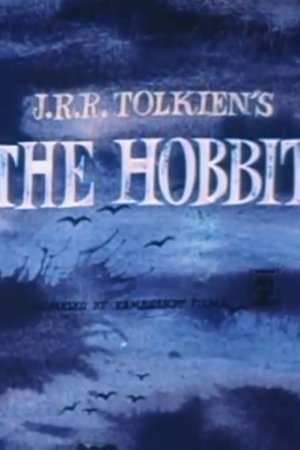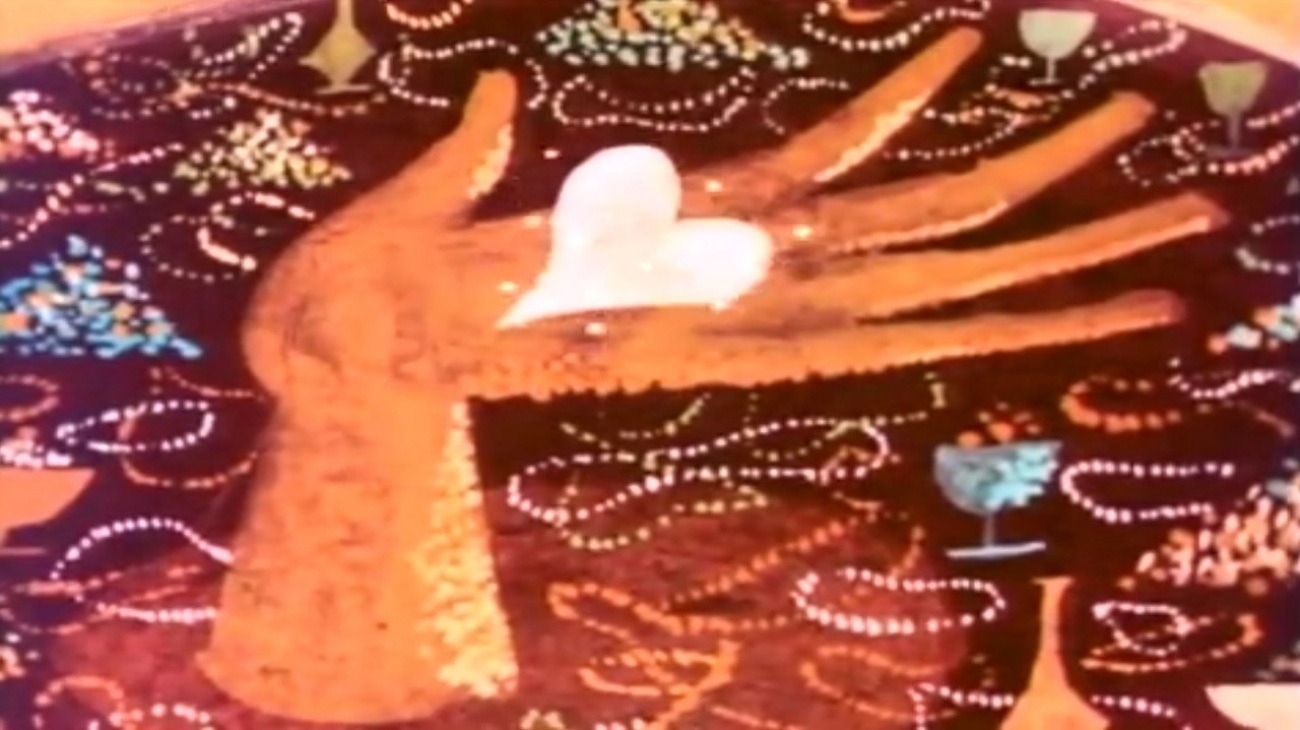
The poor little hobbit sat down in the hall and put his head in his hands, and wondered what had happened, and what was going to happen
It was only in the process of reviewing the animated 1977 The Hobbit - the second-ever filmed adaptation of a work by J.R.R. Tolkien - that I discovered that the first-ever Tolkien adaptation was as close as a YouTube search. And thus it is that I present the much-rarer 1966 short version of The Hobbit, made when producer William L. Snyder found that he needed to do absolutely any damn thing with the property, or risk losing the rights.
Part of me would like very much to just walk away without any commentary, but that would be contrary to Alternate Ending's mission as the place where you go for film reviews that are much longer than they really need to be. Anyway, the thing is too goddamn strange to wander right on by without even a little bit of an attempt to wrap my head around it. Fortunately, we have a cheat sheet in decoding the seemingly intractable "what the fuck?" of it in the form of this post by the film's writer-director Gene Deitch (Ctrl+F "hobbit" if you want to get to the salient part), a man with a terrifically chatty way of telling a story that I wouldn't even feel right trying to summarise. Go read it, it's a blast.
The short version, if you didn't read it: when Tolkeinmania was exploding in 1966, Snyder had thirty days to produce a "full-color motion picture" adaptation if he wanted to retain the rights he'd bought for a song two years earlier. At the time, the intention was for a lavish, feature-length Hobbit, but financing fell through, and Deitch was tasked with the unenviable job of condensing his extraordinarily loose adaptation of the book into something that could fit on one reel of film. Thus the unrecognisable hatchet job you just saw.
Although, unrecognisable hatchet job or not (and at times pointlessly so: for what conceivable reason in the whole world would "trolls" and "goblins" be changed as "groans" and "grablins"?), the thing is... isn't it also kind of great? Partially as an example of creative filmmaking in maniacally challenging circumstances, but also because it's beautiful on its own terms. The art was done by Czech illustrator Adolf Born (Snyder made a killing on producing cartoons in Czechoslovakia, it seems), a man of great international significance across several forms of media, and while I must own up to being totally ignorant of his work, there's no denying that his style, as demonstrated in this little picture, is quite a treasure: fun to look at, creative and detailed, and every inch the children's book illustration that, deep down inside, is exactly what's going on here.
It's worth mentioning, I rather think, that if The Hobbit wasn't made under such intense limitations, it probably wouldn't look this good: that kind of draftsmanship is simply impossible in full animation that needs to be made on any kind of schedule or budget whatsoever, so only the fact that the film really doesn't meet any meaningful definition of "animation" (except, possibly for the multi-layer tracking shots into the cave and forest) permits the drawings to have this level of texture and depth.
At any rate, I like to think that the film speaks for itself: it's a psychotically bad adaptation of the book, of course, but it manages to be so far removed from anything Tolkien wrote that it comes back out the other side, and it's easy to think of it as a story that, incidentally, includes the names "Bilbo Baggins", "Gandalf", "Thorin Oakenshield" and "Arkenstone" - ironically, this feverish 12-minute capsule is able to include a plot element that the 78-minute Rankin/Bass Hobbit was obliged to drop - but otherwise is a completely original snippet of adventure fantasy, one that is largely charming and boosted immensely by its visual beauty. It's about as unsophisticated as filmmaking gets, but that was forced on it by circumstances, and certainly Deitch did his damnedest to give life to the drawings in the limited way he was able.
Better yet, it speaks well of the people who made it in a way that movies usually don't: Deitch and Born knew to a certainty that this Hobbit was never meant to be seen by any audience but the befuddled half-dozen people that legitimised its one screening, and that it would surely be consigned to the flames the instant it was complete. And yet, they still put effort into making something that looked quite lovely in its off-kilter, Eastern European way, with a lively if opaque story, putting actual love and care into this pointless contractual obligation. I admire that, deeply; the film may be more a curio than a timeless masterpiece, but it's an altogether worthwhile curio, and I'm very happy to have had the opportunity of seeing it.
Part of me would like very much to just walk away without any commentary, but that would be contrary to Alternate Ending's mission as the place where you go for film reviews that are much longer than they really need to be. Anyway, the thing is too goddamn strange to wander right on by without even a little bit of an attempt to wrap my head around it. Fortunately, we have a cheat sheet in decoding the seemingly intractable "what the fuck?" of it in the form of this post by the film's writer-director Gene Deitch (Ctrl+F "hobbit" if you want to get to the salient part), a man with a terrifically chatty way of telling a story that I wouldn't even feel right trying to summarise. Go read it, it's a blast.
The short version, if you didn't read it: when Tolkeinmania was exploding in 1966, Snyder had thirty days to produce a "full-color motion picture" adaptation if he wanted to retain the rights he'd bought for a song two years earlier. At the time, the intention was for a lavish, feature-length Hobbit, but financing fell through, and Deitch was tasked with the unenviable job of condensing his extraordinarily loose adaptation of the book into something that could fit on one reel of film. Thus the unrecognisable hatchet job you just saw.
Although, unrecognisable hatchet job or not (and at times pointlessly so: for what conceivable reason in the whole world would "trolls" and "goblins" be changed as "groans" and "grablins"?), the thing is... isn't it also kind of great? Partially as an example of creative filmmaking in maniacally challenging circumstances, but also because it's beautiful on its own terms. The art was done by Czech illustrator Adolf Born (Snyder made a killing on producing cartoons in Czechoslovakia, it seems), a man of great international significance across several forms of media, and while I must own up to being totally ignorant of his work, there's no denying that his style, as demonstrated in this little picture, is quite a treasure: fun to look at, creative and detailed, and every inch the children's book illustration that, deep down inside, is exactly what's going on here.
It's worth mentioning, I rather think, that if The Hobbit wasn't made under such intense limitations, it probably wouldn't look this good: that kind of draftsmanship is simply impossible in full animation that needs to be made on any kind of schedule or budget whatsoever, so only the fact that the film really doesn't meet any meaningful definition of "animation" (except, possibly for the multi-layer tracking shots into the cave and forest) permits the drawings to have this level of texture and depth.
At any rate, I like to think that the film speaks for itself: it's a psychotically bad adaptation of the book, of course, but it manages to be so far removed from anything Tolkien wrote that it comes back out the other side, and it's easy to think of it as a story that, incidentally, includes the names "Bilbo Baggins", "Gandalf", "Thorin Oakenshield" and "Arkenstone" - ironically, this feverish 12-minute capsule is able to include a plot element that the 78-minute Rankin/Bass Hobbit was obliged to drop - but otherwise is a completely original snippet of adventure fantasy, one that is largely charming and boosted immensely by its visual beauty. It's about as unsophisticated as filmmaking gets, but that was forced on it by circumstances, and certainly Deitch did his damnedest to give life to the drawings in the limited way he was able.
Better yet, it speaks well of the people who made it in a way that movies usually don't: Deitch and Born knew to a certainty that this Hobbit was never meant to be seen by any audience but the befuddled half-dozen people that legitimised its one screening, and that it would surely be consigned to the flames the instant it was complete. And yet, they still put effort into making something that looked quite lovely in its off-kilter, Eastern European way, with a lively if opaque story, putting actual love and care into this pointless contractual obligation. I admire that, deeply; the film may be more a curio than a timeless masterpiece, but it's an altogether worthwhile curio, and I'm very happy to have had the opportunity of seeing it.






